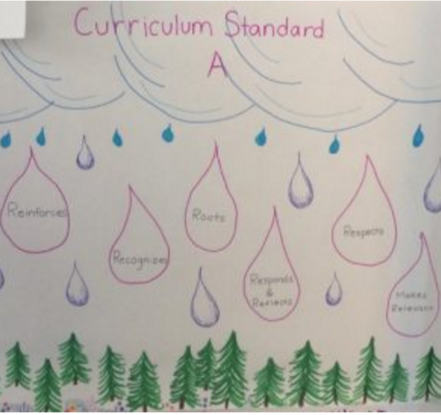My group enjoyed coming up with “R” words to help us remember the elements of standard A for culturally responsive curriculum. I have paraphrased them below!
Reinforces the integrity of culture
Recognizes that culture has both concrete knowledge and deeper values
Roots students in the deeper values of their culture
Responds/Reflects to culture as dynamic, relevant in the past and the present
Respects all cultures of all students
Makes Relevant culture in multiple subjects
My idea for a lesson or activity to incorporate this cultural standard involves having students learn songs by rote (or by ear only instead of reading music) emphasizing the oral tradition of cultures past and present. Students would engage in some kind of conversation about the limitations and values of both Western notation and oral traditions. I really enjoyed hearing about everyone’s ideas for lesson plans and coming up with an easy way to remember how to implement this standard.

Thanks Sophia, I’ve always struggled with listening to music from other cultures because my familiarity with our traditional time signatures makes other music sound off and unpleasant even. I think I could greatly benefit in exploring the limitations of Western notation.
I think that’s a great idea! Maybe even incorporating something from other cultures too–like I know in Scotland when the bagpipes were outlawed a lot of people started singing the songs in order to keep them alive, which has turned into a tradition of its own. Also, as someone who basically grew up in the Alaska Childrens Choir I can say for sure that kids learn how to sing different languages primarily by ear–we learned a compilation song with six different Alaska Native dialects that I can still remember today!
I really liked that your group repurposed the “R” word. There has been a huge push in schools to remove this word from the vernacular of students, and I think this type of model could be useful in several ways.
You know, I was in that group, but until I read your comment it never occurred to me to think of this poster in the context of the “three Rs.” What a good observation. I really like the idea of repurposing the three Rs and making them open-ended and thoughtful and relevant. (Maybe this was the idea all along and I just missed it.)
Aaaand I just saw that it was in the title of the post. Yeah, I definitely missed that during our group discussion. I’m glad the rest of the group was so on the ball.
This was so fun! I am happy that our group worked so well together!
Sophia, I like that you are thinking along the lines of teaching by rote and through aural learning. I also like that you want to focus on the richness of oral traditions. As an orchestral musician in the modern era, I often feel conflicted about notated music. In situations involving traditional non-western musics (as well as modern western music), I find the use of traditional western notation to be stifling, repressive, and often ethnocentric. In the hands of ethnocentric western music scholars, western notation can be a tool of oppression. I have heard classical music authority figures all too often call western music and notation “superior” to the music transmission systems of other cultures. It’s offensive, but a not uncommon viewpoint perpetuated by those in positions of power. So, it’s wonderfully refreshing to see your lesson ideas embracing the notations, transmission systems, and musics of diverse cultures!